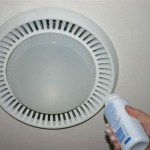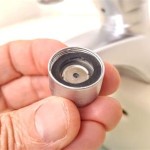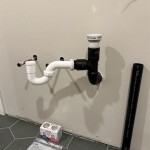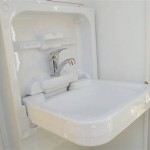How to Clean Out a Smelly Bathroom Sink Drain
A persistent, unpleasant odor emanating from a bathroom sink drain is a common household issue that can be both embarrassing and indicative of underlying problems. Addressing this problem promptly is essential to maintaining a clean and hygienic bathroom environment. The foul smell typically arises from the accumulation of organic matter, such as hair, soap scum, toothpaste, and other debris, within the drainpipe. Over time, this material decomposes, fostering bacterial growth and emitting noxious gases like hydrogen sulfide. Successfully eliminating the odor requires a systematic approach that encompasses dislodging and removing the accumulated debris, sanitizing the drainpipe, and implementing preventative measures to minimize future buildup.
There are several effective methods available for cleaning a smelly bathroom sink drain, ranging from simple home remedies to more involved mechanical techniques. The choice of method will depend on the severity of the clog and the resources available. Before attempting any cleaning procedure, it is crucial to ensure proper ventilation within the bathroom. Opening windows and turning on the exhaust fan will help dissipate any fumes released during the cleaning process and prevent potential respiratory irritation. Additionally, wearing gloves is recommended to protect the skin from contact with bacteria and cleaning agents.
Identifying the Source of the Odor
Before initiating any cleaning procedure, it is beneficial to pinpoint the precise source of the odor. While the drain itself is the most likely culprit, other factors can contribute to the overall smell in the bathroom. Check for mold or mildew growth around the sink basin, faucet, and grout lines. Also, inspect the area beneath the sink for any leaks or spills that might be contributing to the problem. Addressing these secondary sources of odor will enhance the effectiveness of cleaning the drain and create a fresher overall environment.
A simple visual inspection of the drain opening can sometimes reveal the presence of visible debris, such as hair or soap scum. If this is the case, manually removing the debris with a pair of tweezers or a bent wire can immediately improve the situation. However, it is important to note that the majority of the odor-causing material is typically located further down the drainpipe, necessitating more thorough cleaning methods.
Another potential, though less common, contributor to bathroom sink odors is the P-trap. The P-trap is the curved section of pipe located beneath the sink, designed to hold a small amount of water that acts as a barrier, preventing sewer gases from entering the bathroom. If the P-trap dries out, due to infrequent use of the sink or a faulty drain, sewer gases can freely flow into the room. In such instances, simply running water into the sink for a few minutes can replenish the water in the P-trap and eliminate the odor. If the problem persists, further investigation of the drain system is warranted.
Utilizing Natural Cleaning Solutions
For mild odors and minor drain clogs, natural cleaning solutions offer an environmentally friendly and effective alternative to harsh chemical drain cleaners. These solutions typically involve readily available household ingredients, such as baking soda, vinegar, and boiling water.
One popular method involves pouring one cup of baking soda followed by one cup of white vinegar down the drain. The combination of baking soda and vinegar creates a fizzing reaction that helps to dislodge and break down organic matter within the drainpipe. Allow the mixture to sit in the drain for at least 30 minutes, or preferably overnight, to maximize its effectiveness. After the waiting period, flush the drain with a generous amount of boiling water. The boiling water helps to further dissolve any remaining debris and flush it out of the drain system.
Another effective natural cleaning solution involves using a combination of baking soda and lemon juice. The citric acid in lemon juice acts as a natural disinfectant and deodorizer, further enhancing the cleaning power of the baking soda. Simply mix one cup of baking soda with a half cup of lemon juice until a paste forms. Apply the paste to the drain opening and allow it to sit for approximately 30 minutes before flushing with hot water.
For a more powerful natural cleaning solution, consider using borax. Borax is a naturally occurring mineral compound that possesses excellent cleaning and deodorizing properties. Pour approximately one-half cup of borax down the drain, followed by two cups of boiling water. Allow the solution to sit overnight before flushing with hot water. Exercise caution when handling borax, as it can be irritating to the skin and eyes. Wear gloves and avoid direct contact with the powder.
Employing Mechanical Cleaning Methods
When natural cleaning solutions prove insufficient in eliminating the odor and clearing the drain, mechanical cleaning methods may be necessary. These methods involve physically dislodging and removing the debris from the drainpipe using specialized tools. Two common mechanical cleaning tools are the plunger and the drain snake.
A plunger can be effective for dislodging relatively minor clogs that are located close to the drain opening. Ensure there is enough water in the sink to cover the cup of the plunger. Create a tight seal around the drain opening with the plunger and vigorously plunge up and down for several minutes. The pressure created by the plunging action can often dislodge the clog and allow water to flow freely. If the sink has an overflow drain, it is important to cover it with a damp cloth or your hand to prevent air from escaping and reducing the effectiveness of the plunging action.
A drain snake, also known as a plumbing snake or auger, is a flexible tool that can be inserted into the drainpipe to break up or retrieve clogs that are located further down the drain system. Insert the drain snake into the drain opening and carefully rotate it as you push it further into the pipe. When you encounter resistance, indicating the presence of a clog, continue rotating the snake to break up the clog or hook onto it. Once you have successfully broken up or hooked onto the clog, slowly pull the snake back out of the drain, removing the debris along with it. It is important to exercise caution when using a drain snake to avoid damaging the drainpipe.
In some cases, it may be necessary to disassemble the P-trap to manually remove a stubborn clog. Place a bucket or container beneath the P-trap to catch any water or debris that may spill out. Carefully loosen the slip nuts that connect the P-trap to the drainpipes and remove the P-trap. Inspect the P-trap for any accumulated debris and remove it manually. Clean the P-trap thoroughly with soap and water before reassembling it. Ensure that the slip nuts are tightened securely to prevent leaks.
If the mechanical methods fail, consider a high-pressure water jet. These tools deploy a concentrated jet of water to blast away clogs. Use these with care, ensuring proper draining is available during use.
Implementing Preventative Measures
Preventing the accumulation of debris in the drainpipe is essential for maintaining a clean and odor-free bathroom sink. Implementing preventative measures can significantly reduce the frequency of drain cleaning and minimize the risk of future clogs.
One of the most effective preventative measures is to install a drain strainer or screen over the drain opening. Drain strainers are inexpensive and readily available at most hardware stores. They effectively capture hair, soap scum, and other debris before they can enter the drainpipe, preventing them from accumulating and causing clogs. Regularly clean the drain strainer to remove any accumulated debris. Replace the strainer when it becomes damaged or worn.
Avoid pouring grease, oil, or food scraps down the drain. These materials solidify as they cool, forming sticky deposits that can clog the drainpipe and contribute to unpleasant odors. Dispose of these materials properly in the trash or compost bin.
Flush the drain with hot water regularly, especially after using the sink for activities that generate a lot of soap scum or hair. The hot water helps to dissolve and flush away any loose debris, preventing it from accumulating and causing clogs.
Periodically pour a small amount of enzyme-based drain cleaner down the drain. Enzyme-based drain cleaners contain beneficial bacteria that break down organic matter, preventing it from accumulating and causing odors. Choose an enzyme-based drain cleaner that is specifically designed for use in bathroom sinks and follow the manufacturer's instructions carefully.
Consider using a drain maintenance product that releases a slow-release enzyme solution into the drainpipe over time. These products can help to prevent the buildup of organic matter and maintain a clean and odor-free drain system.
Regular maintenance of the drain and careful disposal habits will significantly reduce the likelihood of recurring drain problems and maintain a fresh and hygienic bathroom environment.

How To Clean A Stinky Sink Drain By Home Repair Tutor
:max_bytes(150000):strip_icc()/__opt__aboutcom__coeus__resources__content_migration__mnn__images__2018__08__sink_drain-351af8e441034f319fe07f00c091d8b6.jpg?strip=all)
How To Clean A Smelly Drain Naturally

How To Clean A Stinky Sink Drain Home Repair Tutor

How Can I Help A Stinky Bathroom Sink Drain Cleaning More

How To Clean A Smelly Sink

Prevent Drain Smells Deodorize Your Drains

Why Your Drain Smells And How To Fix It Fast

5 Things To Try If You Have A Noisy Shower Or Bathroom Sink Drain

How To Clean Stinky Drains Liquid Plumr

How To Clean A Bathroom Sink Drain Smell Get Rid Of
Related Posts






